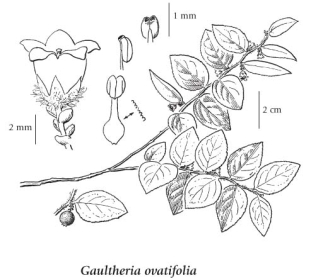Gaultheria ovatifolia A. Gray
western tea-berry (Oregon wintergreen; western teaberry)
Ericaceae (Crowberry family)
Introduction to Vascular Plants
western tea-berry (Oregon wintergreen; western teaberry)
Ericaceae (Crowberry family)
Introduction to Vascular Plants
Species Information
General:
Low, spreading shrub, to 5 cm tall; stems slender, to 20 cm long, very fine brownish-hairy.
Leaves:
Alternate, evergreen, leathery, egg-shaped to almost heart-shaped, (1.5) 2-4 cm long, (1) 1.5-3 cm wide, tips pointed; margins usually conspicuously sharp-toothed and thickened.
Flowers:
Solitary in leaf axils; flower stalks short, with bractlets; corollas white or pinkish, bell-shaped, 5-lobed, 3.5-5 mm long; calyces brown, about 2 mm long, reddish brown-hairy; anthers opening by terminal pores, without awns.
Fruits:
Berrylike, bright red, globe-shaped, 6-8 mm wide.
Illustration

If more than one illustration is available for a species (e.g., separate illustrations were provided for two subspecies) then links to the separate images will be provided below. Note that individual subspecies or varietal illustrations are not always available.
Illustration Source: The Illustrated Flora of British Columbia
Ecology
Ecological Framework for Gaultheria ovatifolia
The table below shows the species-specific information calculated from
original data (BEC database) provided by the BC Ministry of Forests and Range.
(Updated August, 2013)
The table below shows the species-specific information calculated from
original data (BEC database) provided by the BC Ministry of Forests and Range.
(Updated August, 2013)
| Site Information |
Value / Class |
||
|
Avg |
Min |
Max |
|
| Elevation
(metres) |
942 | 41 | 2100 |
| Slope
Gradient (%) |
30 | 0 | 150 |
|
Aspect (degrees) |
196 | 0 | 360 |
| Soil
Moisture Regime (SMR) [0 - very xeric; 4 - mesic; 8 - hydric] |
3 | 0 | 8 |
| Modal
Nutrient Regime
Class |
C | ||
| #
of field plots species was recorded in: |
582 | ||
| Modal
BEC Zone Class |
ICH | ||
|
All BEC Zones (# of stations/zone) species was recorded in |
BWBS(2), CWH(86), ESSF(46), ICH(332), IDF(10), MH(78), MS(9), SBS(3) | ||
|
Source:
Klinkenberg 2013
|
|||